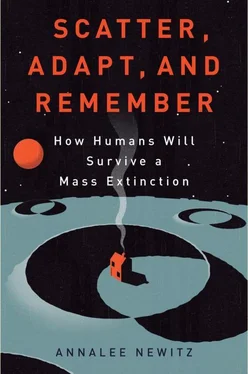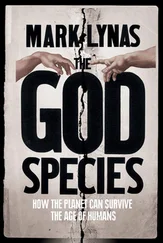4. WHAT REALLY HAPPENED TO THE DINOSAURS
“IT IS VERY hard to imagine what happened,” the paleontologist Jan Smit said. He was describing the minutes and days following the impact of a massive meteorite, possibly 10 kilometers wide, that slammed into the Earth roughly 65 million years ago. Smit is one of the scientists who first discovered evidence for this violent event back in the 1970s. Today many of his colleagues agree that it’s what caused the Cretaceous-Tertiary (K-T) mass extinction—or, as it’s better known, the extinction that ended the dinosaurs.
The Cretaceous Period (145.5 Million–65.5 Million Years Ago): Meteorite Impact
Though nearly everyone is familiar with the story, Smit finds himself constantly correcting people’s misconceptions about it. “It wasn’t like [the movie] Armageddon at all,” he chuckled. The Earth wasn’t wrapped in fire. There were no enormous dust storms choking the life out of the soon-to-be-extinct dinosaurs. Instead, Smit said, most of the molten splash-back from the hit would have been hurled right back into space. And that’s why it was so deadly.
The energy released by the meteorite slamming itself thirty meters deep into Mexico’s Yucatán Peninsula was enough to punch a hole in the atmosphere. As Smit put it, “For this kind of impact, blowing away the atmosphere is a piece of cake.” Tiny droplets of liquified rock and metals shot into space, quickly wreathing our stratosphere in a thick layer of extremely high clouds. The biggest problem was that the meteorite hit Earth in a particularly tender spot, geologically speaking. Beneath the Yucatán, Smit explained, “are three kilometers of limestone, dolomite, magnesium, and gypsum, and salt. Gypsum is about half sulfur. There aren’t that many areas in the world that contain that much sulfur.” Essentially, the meteorite vaporized a hidden cache of explosives and poisons, scattering them everywhere. Still, the mass death that swept the world afterward was not caused by acid rain or other poisons, according to Smit. Instead, it had to do with a peculiar property of vaporized sulfur: When reduced to tiny droplets in the upper atmosphere, the resulting cloud becomes highly reflective. “From space, the planet would have looked brilliantly white,” Smit speculated. For at least a month, Earth became a giant reflector, and little to no sunlight could have penetrated the sulfur-laced clouds. It would have been a very extreme version of what happened after the Permian megavolcano shot sulfur into the atmosphere and cooled the planet.
Below the cloud, it would have been dark for weeks or months. Death would have come quickly to anything that drew sustenance from sunlight, including most plants. Next to die would be plant-eaters whose food sources were gone, followed by starvation among the dinosaur predators at the top of the food chain. Imagine a near-instantaneous food-web collapse, a fast-motion version of the collapses that Roopnarine described as choking off early Triassic life over millions of years. What this means is that one of the planet’s most notorious disasters, complete with cinematic explosions, caused global mass extinction simply by shutting down photosynthesis.
Perhaps more than any of the other mass extinctions we’ve talked about so far, the K-T extinction dramatizes how mass death on Earth is tied to environmental changes. The area around the Yucatán would have been devastated after the meteorite hit. Toxic gas, fire, and extreme tidal waves would have sterilized the region around what is now called the Chicxulub crater. But even the death by darkness that followed would have been just the opening act. It would have taken centuries, and perhaps millennia, before the K-T event achieved full mass-extinction status. The dinosaurs did not die out during one long, sulfur-enhanced night. In fact, Smit underscored that the truly devastating effect of the sulfur cloud was most likely a temperature drop of 10 degrees Celsius that lasted for at least half a century, and probably a lot longer. The lush, green tropics of the Cretaceous cooled, ocean temperatures dropped, and animals who couldn’t migrate found themselves trapped in hostile ecosystems. The mass extinction took out as many as 76 percent of species, including all the non-avian dinosaurs. Meanwhile, a group of mouse-sized furry creatures we know today as mammals began to thrive and grow.
The flaming-ball-of-death controversy
The K-T mass extinction is the most recent one in Earth history, and the evidence it left behind is richer than what we’ve got for any comparable event. As a result, scientists who study the K-T have had to confront the full complexity of life when it collapses. Not surprisingly, this has led to some of the bitterest debates in paleontology.
Smit and a UC Berkeley colleague, the geologist Walter Alvarez, endured years of doubt and ridicule when they first began speculating that the dinosaurs’ demise began with a meteorite. Previously, paleontologists accounted for the mass extinction by suggesting everything from cosmic-ray bombardment to starvation. It took a while for the scientific community to accept the idea of a flaming ball from space. But Smit and Alvarez had pretty compelling evidence. Working on opposite sides of the globe—Smit in Spain, and Alvarez in the Americas—the two researchers uncovered physical remains of the impact and overturned the previous theories about why dinosaurs suddenly went extinct after ruling the planet for over 100 millennia. Alvarez worked with his Nobel Prize–winning physicist father, Luis Alvarez, and the two published a history-making paper in 1980 showing that rock layers at the K-T boundary contained a high concentration of iridium, a metal found almost exclusively in space. Meanwhile, Smit had discovered “spherules,” tiny balls of rock that had been heated up and then cooled down quickly, in the same layer all over the world. Smit published a paper about the spherules the same year Alvarez published his about what’s come to be known as the “iridium anomaly.” The one-two punch of these papers—chronicling metals from space and the remains of superheated rock scattered across the planet—suggested an event whose magnitude could easily have accounted for global mass death.
But the flaming-ball controversy is still far from over. In the late 1980s, Princeton geologist Gerta Keller began publishing papers questioning whether the meteorite impact actually had a global effect after all. She claimed she had a better explanation: megavolcanoes in India. And she spent the next two decades gathering evidence to prove her hypothesis, despite widespread scorn from the scientific community. UC Berkeley paleontologist Charles Marshall said that “nobody in the scientific community takes [Keller] seriously,” and Smit told the BBC that her ideas “are barely scientific.” Like Smit and Alvarez before her, Keller cheerfully met doubt with documentation.
When I spoke to Keller, she had recently returned from India, where she’d made a series of incredible discoveries. She and a group of local scientists managed to get samples three kilometers deep underground in a region called the Deccan Plateau, long known to be the site of an ancient megavolcano. The area has been off limits to scientists ever since India’s Oil and Natural Gas Corporation started drilling there. An outspoken person who clearly loves a good scientific fight, Keller put her considerable powers of persuasion into a campaign to gain access to what she suspected might reveal the truth about how the dinosaurs died. She finally got her wish and, joined by a group of Indian scientists, she found more than she’d ever hoped.
Using special tools that produce “cores,” cylindrical rock samples pulled up from deep underground using cannulated drills, Keller and her colleagues discovered that the Deccan Plateau was the result of at least four major eruptions following closely on each other. One eruption was so enormous that the team found a single uninterrupted lava flow stretching 1,500 kilometers from the volcanic vent all the way to the sea. But the most valuable discovery was the layers of sediment in between each lava flow—in those sediments, Keller and her colleagues found fossils that helped date the volcanic eruptions. Based on the evidence so far, it appears that the Deccan supervolcano began spewing lava and toxic gas about 67.4 million years ago—about 1.6 million years before the K-T boundary. The timing was right. And so were the deadly patterns of extinction she observed in those layers of sediment. After each lava flow, fewer and fewer animals were recovering from the devastation. “By the time the fourth flow came, nothing was left,” she said.
Читать дальше






![Аннали Ньюиц - Автономность [litres]](/books/424681/annali-nyuic-avtonomnost-litres-thumb.webp)





